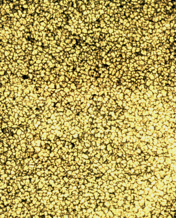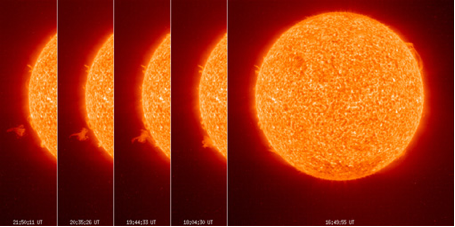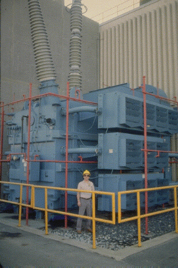The auroral ionosphere
Solar wind and eruptions
<menu30>
To look at the Sun with various wavelengths makes it possible to see its surface at various altitudes under the chromosphere. To 575 nm for example, we can see his granulations, i.e. surfaces it convective layer.

(source : base de donnée solaire BASS2000, Observatoire Midi Pyrénées)
To imagine what occurs, we can proceed by analogy, while looking at boiling a thick soup in a pan. The hottest soup bubbles go up since the bottom to surface and explode. The flame of the cooker represents the nuclear core of the Sun. Although the scale is not respected, the bottom of the pan represents the solar radiative area, in which energy is transported without transfer of matter. Lastly, solar soup is made up of electrons and protons instead of vegetables of the garden. Sights by far, the soup bubbles which go up and which go down resemble grains of rice. The drops which escape from the pan (and which falls down under the effect of terrestrial gravity… no simulation is not perfect !) represent the solar wind. Lastly, evaporation above the pan corresponds to the solar crown. The theorists of the beginning of the century knew, since the experiments of Birkeland in 1903, that the origin of the dawns was in the ejection of the particles of the Sun. Nevertheless, because of the high mass of the star, they refused to consider that this ejection can be permanent. It is Parker, in 1955, which succeeds in showing that by considering a null stellar pressure ad infinitum, the solar crown is not in hydrostatic balance. Consequently, a flow of particles can escape from it continuously. It called this flow of the pretty name of solar wind.
The ionic part of the solar wind is composed of 95% of ions of hydrogen and 5% of helium ions. In the plan of the ecliptic, on the level of the orbit of the Earth, it blows with an average of 400 km.s-1. However of recent observations of the ULYSSES satellite showed that this speed increased up to 750 km.s-1 approximately for solar latitudes higher than 20°. With an astronomical unit, its concentration is of approximately 5 ions and 5 electrons per cubic centimeter in the plan of the ecliptic (thus, each second, about 400 million particles cross each square centimeter at such a distance). The ULYSSES probe also measured that this concentration was divided of half for solar latitudes higher than 20°.

At intervals of approximately 11 years, the Sun knows also periods of strong activity during which dark spots appear on its surface. In these spots, the magnetic field is higher (to a thousand of times) that anywhere elsewhere on the surface of the Sun. Consequently, the matter, sensitive to the magnetic field, is organized there ; the collisions are less frequent and the temperature decrease of 5800 K to approximately 4000 K. When the spots have various polarities, a magnetic tube of force can be created. The electrons and the ions are led along this neutral line by the forces of Lorentz.
Correlatively, phenomena violent one, sporadic, eject fast energy matter. They are eruptions resulting from arcs being able to reach about forty times the diameter of the Earth, or the ejections of mass coronale whose physics is not yet well clarified.
On the Earth, it is followed from there one to three days later of the magnetic disturbances, due to the interaction of the geomagnetic field and magnetic field carried by the solar wind. If their effect is confined with the high latitudes, one speaks about magnetic under-storm. In the cases, much rarer where the disturbances touch the whole of the sphere, one speaks about magnetic storm. The effects can prove to be spectacular. Thus, on March 13th, 1989, a magnetic storm because the breakdown of generators in Quebec, cutting electricity to 6 million Canadians and Americans during 9 hours. The same storm made inflate the terrestrial atmosphere, increasing the friction on satellites, and thus made assemble their orbit ! The forecast of the solar disturbances - and on the basis of the disturbances of our technological world - is the field of a recent branch of astronomy : the meteorology of space.

Updated on 29 mars 2012




